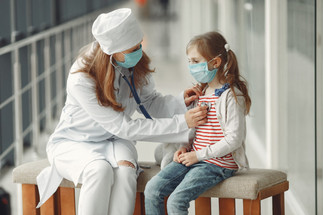About us & our mission with clear masks
About us & our mission with clear masks
AccessibleMasks.org is a passion project–if you appreciate our resource, feel free to support us and keep the site running smoothly!
The mission: accessibility and clear masks
Put yourself in a world where you can't understand anyone you interact with.



The cashier at your local market is casually chatting with you, but you can’t understand them. As you check out, you want to ask a question... but you reconsider asking because you know how difficult it'll be to hear and understand their answer in the loud, busy grocery store environment.
You’re back at school, but it’s really difficult to follow what your teachers and classmates are talking about. In between classes you struggle to socialize with your peers because you're lost—so you nod your head, unaware of the topic at hand.
The doctor is talking to you, but you have no idea what they’re saying. The receptionist at the clinic needs more information and you’re struggling to correctly answer. Or worse, you're in the hospital being treated during this global health crisis and you're left all alone, struggling to understand what nurses are telling you.
This is what it’s like for a deaf person navigating life today.
These are all unique situations that are popping up in the current moment—a global pandemic forcing people to wear face masks to prevent further spread of the deadly disease, COVID-19, caused by the novel coronavirus.
It's bringing about yet another barrier for the deaf and hard of hearing population. That’s about 450 million people globally or about 5% of the world. In the United States, that’s 15% of American adults.
The communication barrier also impacts the elderly since older people are at higher risk of fighting off the deadly COVID-19 disease. 617 million, or 8.5% of people, worldwide are over the age of 65 and, notably, hearing typically degrades with age. So, imagine they're in hospitals and nursing homes navigating the new communication difficulty.
48 million
Americans have hearing loss, according to the ASHA.
It is incredibly precarious for deaf and hard of hearing people, of all ages, to face this new barrier when doing essential activities during the pandemic. They're encountering it when going to the post office, interacting with frontline workers, watching the news on TV, and voting in elections.
At the height of the spring coronavirus surge in the United States, interpreters or visitors weren't allowed into hospitals. Deaf or hard of hearing patients were in a stressful and difficult position where they understandably couldn't ask health care workers to take their masks off amid a global health crisis and they had to resort to time-consuming communication tactics.
But there’s a solution: Clear, transparent face coverings that present more of the wearer’s face and mouth. With “see-through” windows, people can see facial cues, expressions, and lip-read if they need to. Some researchers have suggested that an overwhelming majority of language is non-verbal.
"We know that the virus cannot penetrate plastic or solid materials, so see-through masks provide potentially a great option for balancing infection prevention with the desire to be able to see somebody's mouth move," David Aronoff, director of infectious disease at the Vanderbilt Institute for Infection, Immunology, and Inflammation, told NPR.
In fact, recent research by The Moog Center for Deaf Education found that people have lower error rates in understanding people with clear, see-through face coverings over fully-covered face masks.
Another study in 2017 found a similar conclusion: That people with moderate to severe hearing loss benefited from transparent face masks, compared to hearing and understanding with regular solid masks. The researchers also wrote in their paper that hearing people could also benefit from the see-through masks.
“The potential gains are tremendous: A clear mask makes things accessible for a small segment of the population, but you end up benefiting everybody by doing so,” Bernard Hurwitz, a National Technical Institute for the Deaf (NTID) administrator at the Rochester Institute of Technology, told Popular Science.
As the world adapts to living with coronavirus and the US outbreak continues to infect people nationally, mask usage is becoming a permanent part of our daily lives.
Actually, studies say tens of thousands of lives would be saved if 95% of Americans wore masks. Now, imagine if every one of those were accessible as transparent face coverings.
and help make the masked world accessible.